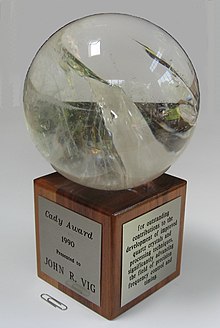John Vig: Difference between revisions
decline speedy, just not seeing anything other than list-like items being copied |
→Career: Link to sensors council |
||
| Line 57: | Line 57: | ||
* IEEE President and CEO.<ref>{{Cite web |date=2021-01-21 |title=List of Presidents of the Institute of Electrical and Electronics Engineers (IEEE) |url=https://ethw.org/List_of_Presidents_of_the_Institute_of_Electrical_and_Electronics_Engineers_(IEEE) |access-date=2022-05-21 |website=ETHW |language=en}}</ref> |
* IEEE President and CEO.<ref>{{Cite web |date=2021-01-21 |title=List of Presidents of the Institute of Electrical and Electronics Engineers (IEEE) |url=https://ethw.org/List_of_Presidents_of_the_Institute_of_Electrical_and_Electronics_Engineers_(IEEE) |access-date=2022-05-21 |website=ETHW |language=en}}</ref> |
||
* President of the Ultrasonics, Ferroelectrics, and Frequency Control Society (UFFC-S)<ref>{{Cite web |date=2021-03-03 |title=IEEE Ultrasonics, Ferroelectrics, and Frequency Control Society History |url=https://ethw.org/IEEE_Ultrasonics,_Ferroelectrics,_and_Frequency_Control_Society_History |access-date=2022-05-21 |website=ETHW |language=en}}</ref> |
* President of the Ultrasonics, Ferroelectrics, and Frequency Control Society (UFFC-S)<ref>{{Cite web |date=2021-03-03 |title=IEEE Ultrasonics, Ferroelectrics, and Frequency Control Society History |url=https://ethw.org/IEEE_Ultrasonics,_Ferroelectrics,_and_Frequency_Control_Society_History |access-date=2022-05-21 |website=ETHW |language=en}}</ref> |
||
* Founding President of the Sensors Council<ref>{{Cite web |date=2022-01-12 |title=IEEE Sensors Council History |url=https://ethw.org/IEEE_Sensors_Council_History |access-date=2022-05-21 |website=ETHW |language=en}}</ref> |
* Founding President of the [[IEEE Sensors Council|Sensors Council]]<ref>{{Cite web |date=2022-01-12 |title=IEEE Sensors Council History |url=https://ethw.org/IEEE_Sensors_Council_History |access-date=2022-05-21 |website=ETHW |language=en}}</ref> |
||
* Vice President of Technical Activities |
* Vice President of Technical Activities |
||
* Division Director |
* Division Director |
||
Revision as of 11:27, 23 May 2022
This article, John Vig, has recently been created via the Articles for creation process. Please check to see if the reviewer has accidentally left this template after accepting the draft and take appropriate action as necessary.
Reviewer tools: Inform author |
John R. Vig | |
|---|---|
Vig János | |
 | |
| Born | May 31, 1942 Budapest, Hungary |
| Nationality | USA |
| Education | B.S., M.S., Ph.D. |
| Alma mater | The City College of New York, B.S.; Rutgers, The State University of New Jersey, Ph.D. |
| Occupation | Physicist |
| Known for | UV-ozone cleaning, Chemical polishing of quartz surfaces, Polyimide bonding of resonators, Noise in MEMS,Tutorial on quartz resonators[1] |
| Relatives | Miklos Vig |
| Awards | 2020 IEEE Richard M. Emberson Award, 2006 C.B. Sawyer Memorial Award, 1990 IEEE UFFC Cady Award |
| Scientific career | |
| Fields | Physics |
| Institutions | U.S. Army Research Lab, Fort Monmouth, New Jersey, U.S. |
| Thesis | (1969) |
| Doctoral advisor | Prof. Bernard Serin |
John Vig (born 31 May 1942) is a physicist, executive and inventor. His career has been with the U.S. Army Research Lab and he has also been active with the IEEE and is known for his inventions in UV-ozone cleaning, Chemical polishing of quartz surfaces, Polyimide bonding of resonators and Noise in MEMS. His tutorial on quartz resonators is regularly updated and cited over 200 times.

Background and biography
Early life and education
He was born Vig János in Budapest, Hungary. His father was a jeweller. At the age of two, most of his relatives were murdered in concentration camps including Auschwitz, however his father survived[2] the camp at Buchenwald. The family fled Hungary in 1956 during the Hungarian Revolution and immigrated to the US as refugees in 1957. Settling in New York City with his family, he subsequently received a B.S. degree from City College New York in 1964. In 1969 he received a Ph.D. in Physics from Rutgers University. After graduating he began his professional career at the Electronic Components Laboratory at Fort Monmouth.[3]
Career
His professional career spanned roles working as a physicist, electronics engineer, program manager, executive and board member. He performed and led research to develop high-accuracy clocks, sensors and low-noise oscillators. He retired in 2006. Since retirement he consults, primarily to DARPA. He supports research in micro/nano resonators, low-noise oscillators and chip-scale atomic clocks.
He has also served the IEEE in many capacities in managerial, executive and governance roles including:
- IEEE President and CEO.[4]
- President of the Ultrasonics, Ferroelectrics, and Frequency Control Society (UFFC-S)[5]
- Founding President of the Sensors Council[6]
- Vice President of Technical Activities
- Division Director
- Journal senior editor, associate editor and guest editor of special issues
- IEEE Investment Committee member
- Conference technical and general program chair
- Standards coordinating committee chair
He was elected Fellow of the IEEE in 1988 "for contributions to the technology of quartz crystals for precision frequency control and timing."[7]
Family
John comes from a musical family which includes cabaret and jazz singer Miklos Vig (uncle), saxophone and clarinet player György Vig (uncle) and jazz musician Tommy Vig (cousin). John and his wife are avid ballroom dancers.
References
- ^ "John R Vig". scholar.google.com. Retrieved 2022-05-23.
- ^ "Individual Files (male) - Concentration Camp Buchenwald". Arolsen Archives. Retrieved 2022-05-21.
{{cite web}}: CS1 maint: url-status (link) - ^ "Oral-History:John Vig". ETHW. 2021-01-26. Retrieved 2022-05-21.
- ^ "List of Presidents of the Institute of Electrical and Electronics Engineers (IEEE)". ETHW. 2021-01-21. Retrieved 2022-05-21.
- ^ "IEEE Ultrasonics, Ferroelectrics, and Frequency Control Society History". ETHW. 2021-03-03. Retrieved 2022-05-21.
- ^ "IEEE Sensors Council History". ETHW. 2022-01-12. Retrieved 2022-05-21.
- ^ "IEEE Fellow Grade History". ETHW. 2020-03-03. Retrieved 2022-05-21.

